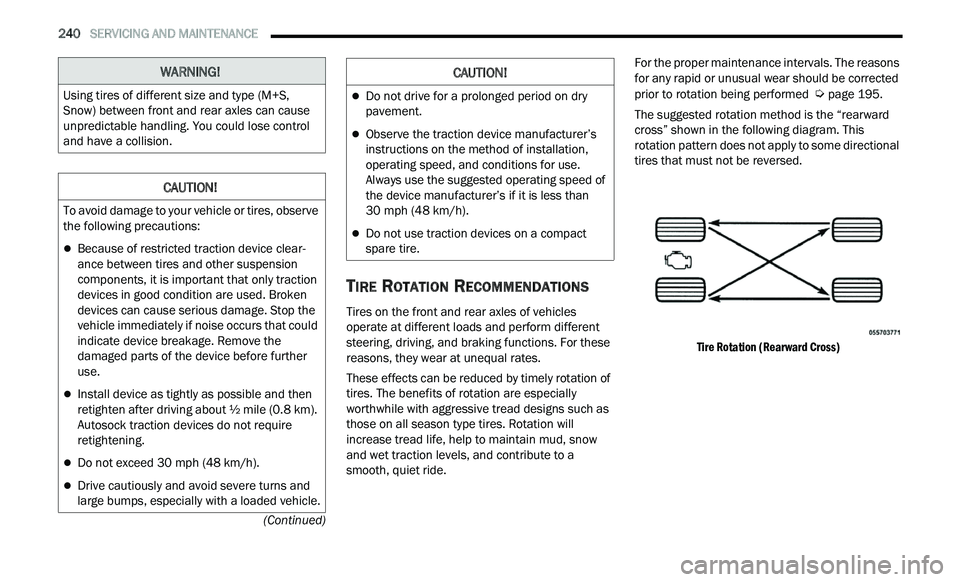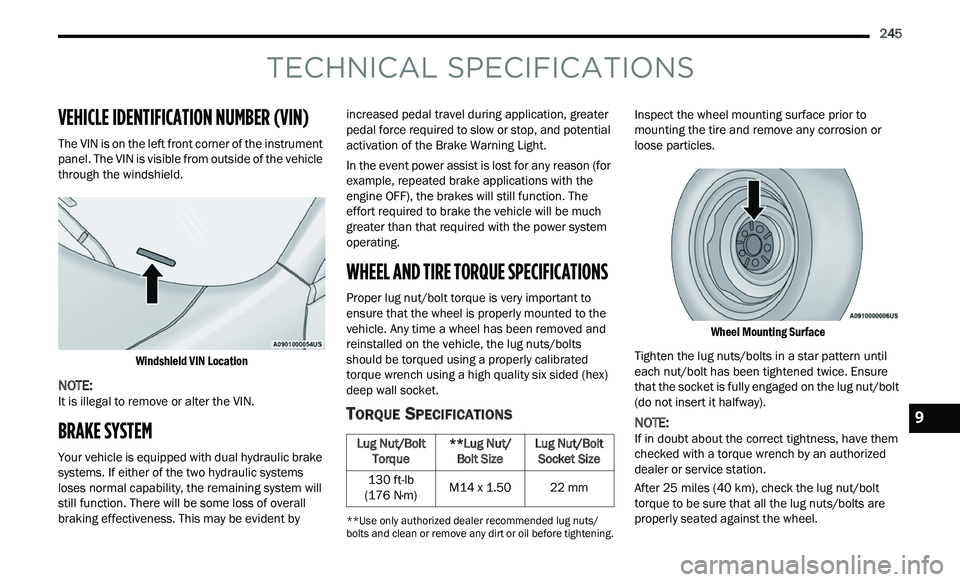2021 CHRYSLER 300 tire size
[x] Cancel search: tire sizePage 239 of 268

SERVICING AND MAINTENANCE 237
Collapsible Spare Tire — If Equipped
The collapsible spare is for temporary emergency
use only. You can identify if your vehicle is
equipped with a collapsible spare by looking at the
spare tire description on the Tire and Loading
Information Placard located on the driver’s side
door opening or on the sidewall of the tire.
Collapsible spare tire description example:
165/80-17 101P.
Since this tire has limited tread life, the original
e
q
uipment tire should be repaired (or replaced)
and reinstalled on your vehicle at the first
opportunity.
Inflate collapsible tire only after the wheel is
pr
operly installed to the vehicle. Inflate the
collapsible tire using the electric air pump before
lowering the vehicle. Do not install a wheel cover or attempt to mount a
c
on
ventional tire on the collapsible spare wheel,
since the wheel is designed specifically for the
collapsible spare tire.
Full Size Spare — If Equipped
The full size spare is for temporary emergency use
only. This tire may look like the originally equipped
tire on the front or rear axle of your vehicle, but it is
not. This spare tire may have limited tread life.
When the tread is worn to the tread wear
indicators, the temporary use full size spare tire
needs to be replaced. Since it is not the same as
your original equipment tire, replace (or repair) the
original equipment tire and reinstall on the vehicle
at the first opportunity.
Limited Use Spare — If Equipped
The limited use spare tire is for temporary
emergency use only. This tire is identified by a label
located on the limited use spare wheel. This label
contains the driving limitations for this spare. This
tire may look like the original equipped tire on the
front or rear axle of your vehicle, but it is not.
Installation of this limited use spare tire affects
vehicle handling. Since it is not the same as your
original equipment tire, replace (or repair) the
original equipment tire and reinstall on the vehicle
at the first opportunity.WARNING!
Compact and collapsible spares are for temporary
emergency use only. With these spares, do not
drive more than 50 mph (80 km/h). Temporary
us
e spares have limited tread life. When the tread
is worn to the tread wear indicators, the
temporary use spare tire needs to be replaced. Be
sure to follow the warnings, which apply to your
spare. Failure to do so could result in spare tire
failure and loss of vehicle control.
WARNING!
Compact and Collapsible spares are for temporary
emergency use only. With these spares, do not
drive more than 50 mph (80 km/h). Temporary
us
e spares have limited tread life. When the tread
is worn to the tread wear indicators, the
temporary use spare tire needs to be replaced. Be
sure to follow the warnings, which apply to your
spare. Failure to do so could result in spare tire
failure and loss of vehicle control.
WARNING!
Limited use spares are for emergency use only.
Installation of this limited use spare tire affects
vehicle handling. With this tire, do not drive
more than the speed listed on the limited use
spare wheel. Keep inflated to the cold tire
inflation pressures listed on your Tire and
Loading Information Placard located on the
driver’s side B-pillar or the rear edge of the
driver’s side door. Replace (or repair) the original
equipment tire at the first opportunity and
reinstall it on your vehicle. Failure to do so could
result in loss of vehicle control.
8
Page 241 of 268

SERVICING AND MAINTENANCE 239
SNOW TRACTION DEVICES
Use of traction devices require sufficient tire-to-body clearance. Due to limited clearance, the following snow traction devices are recommended. Follow these
recommendations to guard against damage.
Snow traction device must be of proper size for the tire, as recommended by the snow traction device manufacturer.
No other tire sizes are recommended for use with the snow traction device.
Please follow the table below for the recommended tire size, axle and snow traction device:
RWD
Trim Level Axle
Tire/Wheel SizeSnow Traction Device (maximum
p r
ojection beyond tire profile or equivalent)
Touring RearP215/65R17
P225/60R18Peerless Chain Super Z6 Low Profile
or
Equivalent
300C 300S NONE
Limited RearP225/60R18
Peerless Chain Super Z6 Low Profile
or
Equivalent
AWD
Trim Level Axle
Tire/Wheel SizeSnow Traction Device (maximum
p r
ojection beyond tire profile or equivalent)
Touring
300S
Limited Rear
235/55R19
P235/55R19 S Class
8
Page 242 of 268

240 SERVICING AND MAINTENANCE
(Continued)
TIRE ROTATION RECOMMENDATIONS
Tires on the front and rear axles of vehicles
operate at different loads and perform different
steering, driving, and braking functions. For these
reasons, they wear at unequal rates.
These effects can be reduced by timely rotation of
ti
res. The benefits of rotation are especially
worthwhile with aggressive tread designs such as
those on all season type tires. Rotation will
increase tread life, help to maintain mud, snow
and wet traction levels, and contribute to a
smooth, quiet ride. For the proper maintenance intervals. The reasons
f
or
any rapid or unusual wear should be corrected
prior to rotation being performed
Ú page 195.
The suggested rotation method is the “rearward
c r
oss” shown in the following diagram. This
rotation pattern does not apply to some directional
tires that must not be reversed.
Tire Rotation (Rearward Cross)
WARNING!
Using tires of different size and type (M+S,
Snow) between front and rear axles can cause
unpredictable handling. You could lose control
and have a collision.
CAUTION!
To avoid damage to your vehicle or tires, observe
the following precautions:
Because of restricted traction device clear -
ance between tires and other suspension
c om
ponents, it is important that only traction
devices in good condition are used. Broken
devices can cause serious damage. Stop the
vehicle immediately if noise occurs that could
indicate device breakage. Remove the
damaged parts of the device before further
use.
Install device as tightly as possible and then
retighten after driving about ½ mile (0.8 km).
A u
tosock traction devices do not require
retightening.
Do not exceed 30 mph (48 km/h).
Drive cautiously and avoid severe turns and
large bumps, especially with a loaded vehicle.
Do not drive for a prolonged period on dry
pavement.
Observe the traction device manufacturer’s
instructions on the method of installation,
operating speed, and conditions for use.
Always use the suggested operating speed of
the device manufacturer’s if it is less than
30
mph (48 km/h).
Do not use traction devices on a compact
spare tire.
CAUTION!
Page 247 of 268

245
TECHNICAL SPECIFICATIONS
VEHICLE IDENTIFICATION NUMBER (VIN)
The VIN is on the left front corner of the instrument
panel. The VIN is visible from outside of the vehicle
through the windshield.
Windshield VIN Location
NOTE:
It is illegal to remove or alter the VIN.
BRAKE SYSTEM
Your vehicle is equipped with dual hydraulic brake
systems. If either of the two hydraulic systems
loses normal capability, the remaining system will
still function. There will be some loss of overall
braking effectiveness. This may be evident by increased pedal travel during application, greater
pedal force required to slow or stop, and potential
activation of the Brake Warning Light.
In the event power assist is lost for any reason (for
ex
ample, repeated brake applications with the
engine OFF), the brakes will still function. The
effort required to brake the vehicle will be much
greater than that required with the power system
operating.
WHEEL AND TIRE TORQUE SPECIFICATIONS
Proper lug nut/bolt torque is very important to
ensure that the wheel is properly mounted to the
vehicle. Any time a wheel has been removed and
reinstalled on the vehicle, the lug nuts/bolts
should be torqued using a properly calibrated
torque wrench using a high quality six sided (hex)
deep wall socket.
TORQUE SPECIFICATIONS
**Use only authorized dealer recommended lug nuts/
bolts and clean or remove any dirt or oil before tightening.
Inspect the wheel mounting surface prior to
mounting the tire and remove any corrosion or
loose particles.
Wheel Mounting Surface
Tighten the lug nuts/bolts in a star pattern until
ea
ch nut/bolt has been tightened twice. Ensure
that the socket is fully engaged on the lug nut/bolt
(do not insert it halfway).
NOTE:
If in doubt about the correct tightness, have them
c h
ecked with a torque wrench by an authorized
dealer or service station.
After 25 miles (40 km), check the lug nut/bolt
t or
que to be sure that all the lug nuts/bolts are
properly seated against the wheel.
Lug Nut/Bolt Torque**Lug Nut/Bolt Size Lug Nut/Bolt
Soc ket Size
130 ft-lb
( 1
76 N·m) M14 x 1.50
22 mm
9
Page 264 of 268

262
Starting............................................................81Automatic Transmission..............................81Button.........................................................15Cold Weather..............................................83Engine Fails To Start...................................83Starting And Operating....................................81Starting Procedures.........................................81Steering...........................................................23Column Lock...............................................23Power..........................................................92Tilt Column...........................................23, 24Wheel, Heated.............................................24Wheel, Tilt............................................23, 24Storage..........................................................242Storage, Vehicle......................................50, 242Storing Your Vehicle......................................242Stuck, Freeing...............................................192Sun Roof..........................................................58Sunglasses Storage.........................................52Supplemental Restraint System – Air Bag.....159Synthetic Engine Oil.......................................203
T
Telescoping Steering Column...................23, 24Temperature Control, Automatic (ATC)............49Tilt Steering Column.................................23, 24Time Delay
Headlight.....................................................42Tire And Loading Information Placard...........229
Tire Markings................................................225Tire Safety Information.................................225Tires...................................177, 232, 236, 241Aging (Life Of Tires)..................................234Air Pressure..............................................232Chains......................................................239Changing.........................................182, 184Compact Spare.........................................236General Information........................232, 236High Speed...............................................233Inflation Pressure.....................................232Jacking.....................................................184Life Of Tires..............................................234Load Capacity...........................................229Pressure Monitoring System (TPMS)..76, 148Quality Grading.........................................241Radial.......................................................233Replacement............................................235Rotation....................................................240Safety..............................................225, 232Sizes.........................................................226Snow Tires................................................236Spare Tires.............................183, 236, 237Spinning...................................................234Trailer Towing...........................................117Tread Wear Indicators..............................234Wheel Nut Torque.....................................245To Open Hood..................................................59Tongue Weight/Trailer Weight......................116
Towing...........................................................114Behind A Motorhome................................119Disabled Vehicle.......................................193Guide........................................................116Recreational.............................................119Weight......................................................116Towing Behind A Motorhome........................119Traction.........................................................119Traction Control............................................142Trailer Towing................................................114Hitches.....................................................115Minimum Requirements...........................116Tips...........................................................118Trailer And Tongue Weight........................116Wiring.......................................................118Trailer Towing Guide.....................................116Trailer Weight................................................116Transfer CaseFluid.................................................213, 250Maintenance............................................213Transmission....................................................87Automatic..........................................87, 212Fluid..........................................................250Maintenance............................................212Shifting........................................................85Transporting Pets..........................................176Tread Wear Indicators...................................234Trunk Lid (Deck Lid).........................................60Trunk Release Remote Control........................60
Turn Signals..............................................43, 78